Rolling stock of the Keighley and Worth Valley Railway
| Keighley and Worth Valley Railway | |
|---|---|
 | |
| Haworth Station | |
| Locale | West Yorkshire |
| Terminus | Oxenhope |
| Connections | Network Rail at Keighley |
| Commercial operations | |
| Name | Worth Valley Branch |
| Built by | K. & W. V. Rly Co. |
| Original gauge | 4 ft 8 1⁄2 in (1,435 mm) |
| Preserved operations | |
| Owned by | Keighley & Worth Valley Preservation Society |
| Stations | 6 |
| Length | 5 mi (8 km) |
| Preserved gauge | 4 ft 8 1⁄2 in (1,435 mm) |
| Preserved era | 1950's |
| Commercial history | |
| Opened | 13 April 1867 |
| 1881 | Midland Railway takes over ownership of line |
| 1883 | Keighley Station opened in current location |
| 1884 | Great Northern Railway extended into Keighley via part of the Worth Valley Branch |
| 1892 | Mytholmes Tunnel built |
| Closed to passengers | 30 December 1961 |
| Closed | June 1962 |
| Preservation history | |
| 1962 | Keighley and Worth Valley Railway Preservation Society formed |
| 1968 | Worth Valley Line reopened |
| Headquarters | Haworth |
| Website | |
| http://www.kwvr.co.uk/ | |
The Rolling stock of the Keighley and Worth Valley Railway is used on the preserved Keighley and Worth Valley Railway, a 5-mile-long (8 km) branch line that served mills and villages in the Worth Valley and is now a heritage railway line in West Yorkshire, England. It runs from Keighley[1] to Oxenhope.[2] It connects to the national rail network line at Keighley railway station.
Steam locomotives
Operational
| Number & Name | Type | Photograph | Livery | Notes |
|---|---|---|---|---|
| No. 85 | Taff Vale Railway O2 class 0-6-2T | 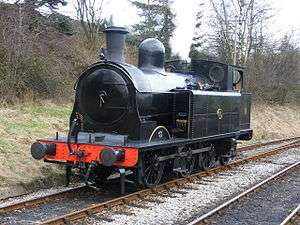 |
TVR lined black | Number 85, along with other members of its class, was introduced to the Taff Vale Railway in 1899. At the grouping in 1923, the Great Western Railway received nine O2 class engines. They were all withdrawn during the 1920s, but No. 85 was bought by the Lambton Hetton & Joicey Colliery Co in Durham, numbered 52. It continued to work at the Philadelphia depot at Houghton-le-Spring until 1968.
Number 85 arrived at KWVR at the end of 1970, but although a major restoration was not completed until 2000, where it was restored to original Taff Vale Railway condition for the first time in preservation. The boiler ticket expired in September 2009 and its overhaul was started soon afterwards because of the locomotive's popularity and good condition.[3] The locomotive returned to service in February 2016 for the year's winter steam gala. Boiler ticket expires in 2026.[4] |
| No. 1054 | LNWR Webb Coal Tank 0-6-2T |
LNWR unlined black | Built at Crewe Works in September 1888.[5] Built for freight work, these coal tanks were often used for local passenger trains, and some (including 1054) were fitted with push-pull equipment. From grouping, the LMS numbered it No. 7799. It was withdrawn in January 1939,[5] although it was reinstated to traffic in December 1940 due to World War II. It was one of a fleet of 64 coal tanks passed from LMS to BR ownership, when it was renumbered 58926 and it was shedded in locations as varied as Bangor, Patricroft, Manchester, Bletchley, Edge Hill, Liverpool and Shrewsbury.[5] In the mid-1950s, the locomotive was loaned to the National Coal Board, but had returned to British Rail by 1955. On its return, it was steamed only occasionally, predominantly for stand-by snow-plough duties until it was requested by the Stephenson Locomotive Society to double head a special train to mark the closure of the Abergavenny to Methyr route with 7F No. 49121. Bought by the former shedmaster of Bangor, Mr J. M. Dunn who restored it to LNWR condition.[5] After a short stay at Hednesford, Staffordshire, it found itself donated to The National Trust who later loaned it to the Dinting Railway Centre who put it back into running order for the Rocket 150 celebrations in 1980.[5] When the Dinting Railway Centre ceased to exist in 1990, 1054 moved to the KWVR. The general overhaul of No. 1054 was finished in late 2011. Running in took place over the winter and it is currently operational and used on vintage trains. Boiler ticket expires 2021. | |
| No. 1704 "Nunlow" | Hudswell Clarke 0-6-0T |
 |
Green | Built 1938 by Hudswell Clarke to industrial railway connecting G&T Earle's cement works with the mainline at Hope on the ex-Midland Sheffield to Manchester line.[5] Named Nunlow after a hill that stood on the works site. During the mid-1960s, role was taken over by diesel shunters. Taken to the Dinting Railway Centre in 1969, moved to KWVR in 1990.[5] Property of the Bahamas Locomotive Society, its boiler ticket expires in 2018. |
| No. 5820 "Big Jim" | USATC S160 Class 2-8-0 |
USATC grey | Built as works number 8758 by the Lima company of America in 1945, No. 5820 was shipped to Britain and then almost immediately to France to help with the World War II war effort.[6] After the war had ended, it went to Polish Railways where it was numbered Tr203.474[6] and allocated to Katowice shed.
During the 1970s, Polish steam was in decline while the British preservation movement was growing. No. 5820 was brought to Haworth in November 1977[6] and became known as 'Big Jim'. It reverted to its USATC number the following summer and starred in 'Yanks'. No. 5820 was withdrawn from service in 1992. After a heavy overhaul, the locomotive returned to service in early 2014 in inauthentic BR unlined black livery as No. 95820 before reverting to its more authentic guise as USATC Grey No. 5820. Boiler ticket expires in 2023. | |
| No. 43924 | Midland Railway 3835 Class 0-6-0 (LMS Class 4F) |
.jpg) |
BR unlined black with late crest | Built in October 1920 at Derby Works, it was allocated to Wellingborough where it was deployed on coal trains to London and return of empty wagons.[5] Allocated to Saltley Shed (21A) in March 1930; Gloucester Barnwood (22B) in July 1937; Bristol Barrow Road (82E) in September 1962; withdrawn in July 1965.[5] Sold and transferred to Woodham Brothers in October 1965. Became the first locomotive in September 1968 to leave Barry scrapyard and earned a reputation as a reliable KWVR performer until it was withdrawn from service in December 1987. 43924 re-entered revenue-earning passenger service in July 2011 for the first time in nearly 25 years after an extensive overhaul. Boiler ticket expires in 2021. |
| No. 90733 | BR 2-8-0 Austerity |  |
BR unlined black with late crest | Built at the Vulcan Foundry (No.5200), for the War Department (WD No. 79257), dispatched in January 1945. Shipped over to NSR Netherlands, No. 4464.[5] Limited history in the Netherlands, but allocated to Rietlanden at the beginning of 1949, before moving to Eindhoven. Sold to Swedish State Railways in 1953, moved to Örebro works to have: new fully enclosed cab; electric lighting; shortening of tender (to enable it to fit Swedish turntables); renumbered Class G11 No. 1931.[5] Mothballed with No. 1930 in 1958. Inspected in 1972 by KWVR, arrived at Ingrow 1973. After three years of operations, withdrawn 1976. Heavy overhaul began in 1993, completed 2007. Renumbered to the number subsequent to the last UK BR owned WD 2-8-0 – No. 90733 – returned to traffic.[7] Boiler ticket expires 2017.[8] |
| No. 75078 | BR 4-6-0 Class 4MT | 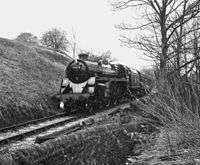 |
BR lined black with late crest | No. 75078 was built at Swindon in 1956, one of 15 heading for the Southern Region.[9] Initially based at Exmouth Junction (72A), it moved away to Basingstoke (70D) in May of that year. 75078 was fitted with a double chimney during overhaul in October 1961. In March 1963, it was moved to Nine Elms (70A), the main shed for London Waterloo and in May 1965, it was moved to Eastleigh (70D).
No. 75078 was withdrawn in 1966,[10] and sent to Barry scrapyard in South Wales where it languished for five and a half years until it left to take up residence at the KWVR in 1972, where it has remained ever since. Returned to service in February 2015 after more than 16 years out of traffic.[11] Boiler ticket expires in 2024. |
Currently elsewhere
| Number & Name | Description | Photograph | Livery | History and Current Status |
|---|---|---|---|---|
| No. 752 | L&YR Class 23 0-6-0ST | 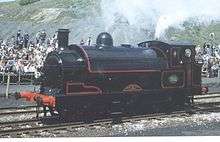 |
N/A | Built in 1881 by Beyer Peacock as works number 1989 for the Lancashire and Yorkshire Railway as a class 25 (similar to No. 957), it was rebuilt in its present form of an 0-6-0ST in 1896 at Horwich Works.[12] Now as a class 23, it was a common site on both local goods and shunting turns. It was allocated to Wigan locomotive shed in 1921 and remained there until it was disposed of by the LMS in April 1937 (now numbered 11456) being loaned and then sold to the Blainscough Colliery Co Ltd, which was nationalised in 1947. It ran on NCB metals until 1968.[12]
It is now under the ownership of the Lancashire & Yorkshire Railway Trust. Restoration was started in 1968 at the factory site of Yates Duxbury & Son Ltd in Heap Bridge near Bury, before moving to the KWVR in 1971. It is once again undergoing restoration, which is being undertaken at the East Lancashire Railway. |
| No. 5775 | 5700 Class 0-6-0PT | .jpg) |
GN&SR Ochre | Built for the Great Western Railway in September 1929 and worked at Neath shed in South Wales. At Nationalisation, it was at 87C shed – Danygraig, where it stayed until transfer to Carmarthen (87G) and finally to Pontypool Road (86G).[5] Sold to London Transport in July 1963,[5] numbered L89 and repainted in LT maroon livery. No. 5775 moved to KWVR in January 1970[5] where it starred as the locomotive that hauled the Old Gentleman's train in 'The Railway Children' film . Currently at the National Railway Museum Shildon following cosmetic restoration into its 'Railway Children' livery for the 45th anniversary of the film. |
| No. 34092 "City of Wells" | SR 4-6-2 West Country Class |  |
BR lined green with early crest. | Built in March 1949, No. 34092 was a member of the final batch of 20 West Country Class locomotives ordered.[13] It was based at Stewarts Lane (73A) until it was moved to Salisbury (72B). While at Stewarts Lane, it was named 'Wells' by the mayor of Wells on 25 November 1949[13] (changed to 'City of Wells', unique amongst the rest of its class which were named only after the town, city or region, in March 1950). No. 34092 was often called upon to haul the Golden Arrow service and was further chosen to haul special trains for the visit of Bulganin and Kruschev, and King Faisal II of Iraq.
Having covered 502,864 miles (809,281 km),[14] No. 34092 was sent to Woodham's scrapyard. However, in 1971, it was bought by the KWVR and, after overhaul, was used throughout the 1980s both on the branch and on mainline excursions. A Giesl ejector was fitted in 1985. No. 34092 returned to service in August 2014 following an extensive overhaul. The locomotive is also planned to return to traffic on the mainline when funding is available to purchase the equipment needed for use on Network Rail. No. 34092 is currently on loan to the East Lancashire Railway until the end of 2016 due to there being a weight restriction at Ingrow, this restriction has since being lifted allowing 34092 to return home later in 2016 as well as visiting locomotives and other residents. |
| No. 45212 | LMS Black Five 4-6-0 | 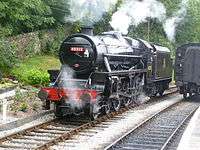 |
BR Lined Black with late crest. | No. 5212 was built by Armstrong Whitworth's Newcastle works, and entered traffic in November 1935, with its home being Bradford Low Moor (25F), where it was often tasked with working Transpennine trains.[5] In November 1947, No. 5212 moved to Fleetwood shed (24F), and in October of that year it was renumbered to become No. 45212.[5] In October 1964, it was shedded at Carnforth (10A); moving in March 1965 to Speke Junction (8C); back to Carnforth in June 1965; to Carlisle Kingmoor (12A) in September 1965 and upon closure, to Lostock Hall (10D). No 45212 moved to the KWVR in October 1968.[5]
The locomotive has recently returned from the Ian Riley Engineering workshop in Bury on the East Lancashire Railway after completion of a complete overhaul to Network Rail standards, and she will be painted and then begin her running in period on the railway before going out on the mainline later in 2016. Boiler ticket expires in 2026. Currently having mainline equipment fitted at Ian Riley's workshop in Heywood.[8] |
| No. 45596 "Bahamas" | LMS 4-6-0 Class 5XP Jubilee |  |
BR Lined Green. | Built in January 1935, No. 5596 was named 'Bahamas' without ceremony on 8 June 1936.[15] It ran with both Stanier 4,000 US gallons (15,000 l) and Fowler 3,500 US gallons (13,000 l) gallon tenders. It was renumbered to 45596 in 1948, in line with the rest of the BR renumbering at that time. In 1961, Bahamas was fitted with a double chimney.[15]
Bahamas was purchased by the Bahamas Locomotive Society in 1967 and, after a heavy overhaul at the Hunslet Railway Company in Leeds and a short period of storage, arrived at the Dinting Railway Centre in 1968. Presently, 45596 is at Tyseley Locomotive Works undergoing overhaul to Network Rail standards for use on the mainline, the completion of her overhaul is scheduled for 2017 with running in to take place on the KWVR. |
Undergoing overhaul
| Number & Name | Description | Photograph | Livery | History and Current Status |
|---|---|---|---|---|
| No. 957 | Class 25 "Ironclad" 0-6-0 |
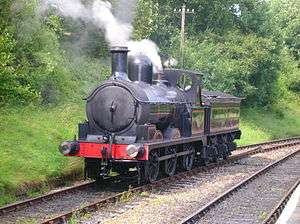 |
L&Y Lined Black. | Designed by Barton Wright for the Lancashire and Yorkshire Railway in 1875/6, No. 957 was delivered by Beyer Peacock in 1887.[5] It was on the books of Goole Shed at grouping, when it became LMS No. 12044; and it remained there until January 1950[5] when British Rail moved it to Wakefield shed (25A).
No. 957 was privately purchased from BR in 1959 and moved to KWVR in 1965 where it became famous for its role in The Railway Children. It was withdrawn from service in 1975 in need of a major overhaul and spent a significant amount of time on display in Oxenhope museum. The major overhaul was eventually started and 957 returned to service in 2001 wearing BR Black livery as No. 52044 before reverting to its L&Y guise of 957 a couple of years later. It was mainly used on summer vintage trains and during special events as well as the occasional normal passenger service. Its boiler certificate expired on 20 January 2013. Following a couple of years on display at Oxenhope, 957 moved back to Haworth in July 2016 with its overhaul now underway. |
| No. 41241 | LMS 2-6-2T Class 2MT |  |
BR Lined Black with late crest. | No. 41241 was built at Crewe Works in 1949 and from there went to Bath Green Park shed (71G).[5] After a few shorts spells at other sheds and transfer back to 71G, it was transferred to Wellington shed (84H) in October 1959. In 1964, No. 41241 was moved to Leamington Spa (2L), back to Wellington and to Wales, where it stayed at Bangor (6H) and Croes Newydd (6C).[5] In 1965, No. 41241 went to Llandudno Junction shed (6G) for about 3 months before finally being transferred to Skipton (10G). It was withdrawn in December 1966, where it was taken under its own steam to its present home on the KWVR,[5] where it was destined to haul the re-opening special. Its boiler 'ticket' expired on 20 January 2013, and is currently undergoing overhaul, requiring extensive firebox work amongst many other required tasks. It is hoped to complete the overhaul in time for the 50th anniversary of the opening of the KWVR in 2018.[3] |
| No. 78022 | BR 2-6-0 Class 2MT | .jpg) |
BR Lined Black with late crest. | Built at Darlington Works in 1954 and was allocated to Millhouses Depot in Sheffield. Its final allocation was Lostock Hall in Preston, where it was withdrawn from British Rail service in February 1967. 78022 was purchased in 1975 and, following an extensive restoration, was returned to service in 1993. It proved to be a popular locomotive, capable of handling most of the Worth Valley's trains. It was withdrawn for a ten-year overhaul at the end of 2000 and was moved to Oxenhope for display inside the museum. It was moved back to Haworth in May 2014 for preparations for overhaul, which started in early 2015 following the completion of 75078. The boiler was lifted out of the frames in March 2015 and the wheels removed the following year. |
Stored, static or on display
| Number & Name | Description | Photograph | Livery | History and Current Status |
|---|---|---|---|---|
| No. 47279 | LMS 0-6-0T Class 3F "Jinty" | 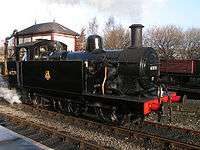 |
BR Unlined Black with early crest. | Built by the LMS following a previous Midland design, the Jinties were mainstay locomotives on the Worth Valley in its pre-preservation years. No. 7119 left the Vulcan Foundry in 1924.[5] Under the LMS 1934 renumbering scheme, it became No 7279 and finally at Nationalisation, it became 47279. This locomotive had an active life, and transferred between many areas and sheds in the LMS and later LMR. It was bought by Woodham Brothers Scrapyard, and arrived at their scrapyard in Barry in 1967. After 12 years rotting in the scrapyard, No 47279 arrived at Haworth in 1979. A very extensive restoration was carried out and 47279 entered service in February 1988.[5] A further overhaul and return to service were completed in 2001 and 47279 gave ten years of reliable service before being retired from service on 23 July 2011 upon the expiry of its '10-year' boiler ticket. It is now on display in the museum at Oxenhope. |
| No. 48431 | LMS 2-8-0 Class 8F | 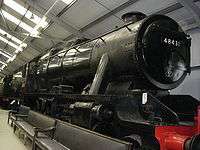 |
BR Unlined Black with late crest. | Built in 1944. An example of Sir William Stanier's 8F heavy freight locomotives. They played a very important role during World War II as they were built to keep the traffic moving in the United Kingdom and to support an Allied advance in Europe. In 1955 48431 was transferred to BR's Western region, being stationed successively at Bristol, Old Oak Common and Bath Green Part up to its withdrawal from service in 1964. After spending 8 years at Barry scrapyard it arrived at Keighley in 1972 and was returned to service in 1975. A further overhaul was undertaken and the locomotive enjoyed another period of operation until it was withdrawn following the expiration of its boiler ticket at the end of 2000. It is now on display in the museum at Oxenhope, awaiting a full 10-yearly overhaul. |
| No. 80002 | BR 2-6-4T Class 4MT | BR Lined Black with early crest. | Part of the first batch of 10 to be ordered by the Scottish Region from Derby Works, emerged in October 1952.[5] Allocated to Motherwell shed (66B); moved to Polmadie (66A). Transferred to Beattock shed (68D) in June 1962.[5] After closure of branches around Beattock, it was moved back to Polmadie in April 1964, where it stayed until retirement in March 1967. After a short spell as a stationary steam heating boiler, moved to KWVR in 1969. Its boiler ticket expired on 22 August 2013 and was moved to the museum at Oxenhope for display in May 2014. | |
| No. 68 | Class 21 "Pug" 0-4-0ST |
.jpg) |
L&YR black | Built in 1901 No. 68 represents the "Pug" class which were small locomotives designed for use in sharply curved sidings. Under LMS ownership it was numbered 11218 and under BR ownership it was numbered 51218. It was the first locomotive to arrive at Haworth in 1964, the same year that it was withdrawn from service in Wales and has since had several periods in steam where it has been seen in its BR guise as 51218 or its present L&Y guise as 68. It is currently awaiting overhaul which is planned to start once 752 is finished. Recently moved into Oxenhope museum for display. |
| No. 31 "Hamburg" | Hudswell Clarke 0-6-0T |
Black. | Built in 1903. "Hamburg" is an example of one of the Manchester Ship Canal "short tanks" which arrived at the railway in 1967. It has been featured in several television programs such as Sherlock Holmes. "Hamburg" is now on display in the museum at Oxenhope, requiring a new inner firebox and a general overhaul. | |
| No. 118 "Brussels" | Hudswell Clarke "Austerity" 0-6-0ST |
 |
LMR blue. | Built in 1945. Requires a general overhaul. |
| No. 2258 "Tiny" | Andrew Barclay 0-4-0ST |
~ | Black. | Built in 1949. On display at Ingrow West awaiting a general overhaul, owned by the Bahamas trust. |
| No. 7069 "Southwick" | Robert Stephenson and Hawthorns 0-4-0 crane tank | ~ | N/A | Built in 1942. In store at Ingrow West awaiting overhaul. |
| "Lord Mayor" | Manning Wardle 0-4-0ST |
~ | Lined green. | Built in 1893. On display at Ingrow West awaiting overhaul. |
Former Worth Valley Residents
| Number & Name | Type | Photograph | Livery | History and Current Status |
|---|---|---|---|---|
| No. 30072 | Class USA 0-6-0T |  |
KWVR Brown | After World War II, the Southern Railway needed to replace ageing shunting engines at Southampton Docks. They decided to use the USATC built USA tanks. No 30072 started life at the Vulcan Iron Works in 1943 as works number 4446.[5] After 4 years, the Southern Railway bought and 14 others of its class renumbering it No 72. At nationalisation, 30 000 was added to the number (as was customary for southern engines), and it stayed at Southampton. In 1962, its duties were taken over by diesel shunting engines and No 30072 was moved to Guildford (70C) shed.[5] On 9 July 1967, it was moved to Salisbury for storage, from where it was bought.
When at the Keighley and Worth Valley Railway, it hauled the re-opening special with 41241. It operated as an oil-burning locomotive from 1976 to 1987. 30072 purchased by Andy Booth (the current owner of L&YR Class 27 no 1300) in August 2015 and is presently undergoing an overhaul which is hoped to be ready intime for the 50th anniversary of the opening of the KWVR in 2018. The engine's overhaul is being undertaken at the Ribble Steam Railway and upon completion she will return on loan to the railway.[16] |
| No. 46115 "Scots Guardsman" | LMS Royal Scot 4-6-0 |  |
BR lined green with the late crest | No. 46115 was based on the line for a while but due to weight restrictions didn't see much use. Departed the line in the 1970s for overhaul to mainline condition and was later painted into LMS Black. Currently owned by David Smith and based at Carnforth MPD. |
Diesel locomotives and Multiple Units
Operational
| Number & Name | Description | Photograph | Livery | Current Status |
|---|---|---|---|---|
| No. D2511 | BR 0-6-0 British Rail Class D2/12 | .jpg) |
BR Green with wasp stripes. | In use as the Carriage yard shunter at Oxenhope. |
| No. 32 "Huskisson" | Mersey Docks and Harbour Board Diesel Mechanical 0-6-0 | Black | Back in service for the 2014 Diesel Gala after a long delayed overhaul.[17] | |
| No. D0226 "Vulcan" | BR 0-6-0 Prototype EE shunter | BR Green. | Used as the Haworth yard shunter. | |
| No. 08266 (ex 13336) | BR 0-6-0 Class 08 | ~ | BR Departmental Grey | In use but restricted to Haworth yard duties as the locomotive is currently suffering from worn tyres. Appeared at 2008 diesel gala working shuttles between Keighley and Ingrow. |
| No. 08993 "Ashburnham" | BR 0-6-0 Class 08 |  |
EWS Maroon and Gold. | Built in 1959 as No. D3759 and later 08592. The locomotive was later rebuilt with a cut down cab and body for use on the Burry Port and Gwendraeth Valley Railway. It was purchased by the KWVR in August 2015 as a replacement for No. 08266 and arrived in September that year. It returned to service following a light overhaul in June 2016. The loco is dual braked, making it useful for shunting air brake only vehicles.[18] |
| No. 20031 (ex-D8031) | BR Bo-Bo Class 20 | 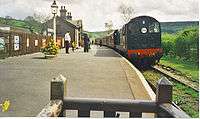 |
Railfreight Coal Sector 3 Tone Grey. | Returned to traffic in September 2008 after a second main generator repair. Currently available for use. |
| No. 25059 (ex-D5209) | BR Bo-Bo Class 25 | 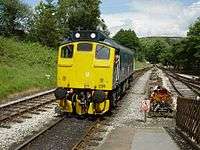 |
BR Blue with full yellow ends. | Built in 1963. Restored to traffic following bodywork repairs, mainly to cab floors. Was in traffic for diesel gala, but then withdrawn from traffic again for the second cab to be repaired. Cab interior refurbishment and a repaint will follow. |
| No. 37075 | Class 37 | ~ | Railfreight Grey with full yellow ends. | Built in 1962. Operational. The loco has two different types of nose end. |
| Nos. 51803+51189 | BR Class 101 unit. | BR Green with yellow warning panels. | Returned to service in 2013 following restoration and now in regular use. | |
| No. 79964 | BR Waggon und Maschinenbau Railbus | BR Green with yellow warning panels. | In regular use on morning diesel services. |
Out of service
| Number & Name | Description | Photograph | Livery | Current Status |
|---|---|---|---|---|
| No. 23 "Merlin" | Port of Bristol Authority Diesel Mechanical 0-6-0 |  |
Unlined Black. | Previously in use at Oxenhope station as the carriage and wagon yard shunter, now withdrawn due to poor mechanical condition and stored at Haworth MPD until its turn for overhaul. |
| Nos. 50928+51565 | Class 108. | 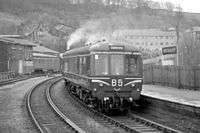 |
BR Green (50928 has speed whiskers and 51565 has a yellow warning panel). | Was in regular use on morning diesel services from the 1990s until 2013 when it was withdrawn for a well deserved overhaul which it currently awaits. |
| No. 79962 | BR Waggon und Maschinenbau Railbus (See 7) | ~ | BR lined green with wasp stripes. | Undergoing a heavy overhaul in the Vintage Carriage Trust's shed at Ingrow, the engines restoration has been finished. |
Carriages and wagons
Normal Service Stock
| Number & Name | Description | History and Current Status | Livery | Photograph |
|---|---|---|---|---|
| 1013 | BR Mk 1 Restaurant Second Open | built 1951 | BR Maroon | ~ |
| 46157 | BR Mk 1 Second | built 1954 | BR Maroon | ~ |
| 43003 | BR Mk 1 non-gangwayed Lavatory Composite | built 1954 | BR Maroon | ~ |
| 43128 | BR Mk 1 Brake Second | built 1954 | BR Maroon | ~ |
| 43145 | BR Mk 1 Brake Second | built 1955 BR 48011 | BR Maroon | ~ |
| 43345 | BR Mk1 Brake Second | Built 1955 | BR Maroon | ~ |
| 48011 | BR Mk 1 Second Lavatory Open | built 1955 | BR Maroon | ~ |
| 48018 | BR Mk 1 Second Lavatory Open | built 1955 | BR Maroon | ~ |
| 80591 | BR Mk 1 Gangwayed Full Brake | built 1955 | BR Maroon | ~ |
| 43345 | BR Mk 1 Brake Second | built 1955 | BR Maroon | ~ |
| 4588 | BR Mk 1 Tourist Second Open | built 1956 (now bar car) | ~ | |
| 4304 | BR Mk 1 Tourist Second Open | built 1956 | BR Maroon | ~ |
| 4306 | BR Mk 1 Tourist Second Open | built 1956 | BR Maroon | ~ |
| 4467 | BR Mk 1 Tourist Second Open | built 1956 | BR Maroon | ~ |
| 9273 | BR Mk 1 Brake Second Open | built 1956 | BR Maroon | ~ |
| 4774 | BR Mk 1 Tourist Second Open | built 1957 | BR Maroon | ~ |
| 4840 | BR Mk 1 Tourist Second Open | built 1959 | BR Maroon | ~ |
| 4900 | BR Mk 1 Tourist Second Open | built 1960 | BR Maroon | ~ |
| 1963 | BR Mk 1 Unclassed Restaurant Car (later RK) | built 1960 | BR Maroon | ~ |
| 1836 | BR Mk 1 Restaurant Miniature Buffet | built 1960 | BR Maroon | ~ |
| 4955 | BR Mk 1 Tourist Second Open | built 1961 | BR Maroon | ~ |
Vintage carriages and carriages for special use
The railway has amassed a large collection of Vintage Carriages over the years. Some are used to carry passengers on specially selected open days.
| Number & Name | Description | History and Current Status | Livery | Photograph |
|---|---|---|---|---|
| 1867 | GNR | Incomplete | N/A | ~ |
| 154 | MSLR Tricomposite, luggage compartment | Built 1876. On display. | Great Central Railway. | ~ |
| 1507 | LYR 6 wheel 5 compartment Third | Built 1882. Uses underframes of LMS 32988 BGZ built 1938. Operational. | L&YR lined black and brown. |  |
| 358 | MR 6 wheel Composite | Built 1886. Undergoing restoration. | Railway Children red and white. | ~ |
| 589 | GNR 6 wheel Brake Third | Built 1888. Undergoing restoration. | Varnished teak. | ~ |
| 279 | LYR 4 compartment First | Body only, built 1894. Running on under-frames from LMS 33007 BGZ (built 1940). Undergoing restoration. | N/A | ~ |
| 2856 | GNR Composite Lavatory Brake | Built 1898. On display. | GNR varnished teak. | ~ |
| 1661 | NER Clerestory Saloon | Built 1904. On display. | LNER varnished teak. |  |
| 135 | LYR Director's Saloon | Built 1908. On display. | L&YR lined black and brown. | ~ |
| 1474 | LYR Hughes taper-end Brake | Built 1910. Operational. | L&YR lined black and brown. | _built_1910.jpg) |
| 427 | Metropolitan 'Dreadnought' Brake | Built 1910. Operational. | London Transport brown. | ~ |
| 47 | LYR Blackpool Club Car | Built 1912. Running on BR 46145 Mk1 Second (built 1954) under-frames. Operational. | L&YR lined black and brown. |  |
| 465 | Metropolitan 'Dreadnought' 9-compartment third | Built 1919. Operational. | London Transport brown. |  |
| 509 | Metropolitan 'Dreadnought' 7-compartment First | Built 1923. Operational. | Metropolitan Railway lined varnished teak. | |
| 3554 | SR 'Matchboard' Continental Brake third | Built 1924. Operational. | BR carmine and cream. | |
| 8761 | LMS CK | Built 1924 (later World War II Ambulance Car). Awaiting restoration. | ~ | |
| 84 | Pullman LNER 255 Pullman Parlour Third "Mary" | Built 1931. Operational. | Pullman umber and cream. |  |
| 83 | Pullman LNER 261 Pullman Parlour Third "Anne" | Built 1931. Operational. | Pullman umber and cream. | ~ |
| 4247 | LNER Gresley BG(P) (Gangwayed Full Brake/Pigeon Van) | Built 1938. On display. | BR maroon. | ~ |
| 12066 | LMS 9-compartment Third | Built 1938. Awaiting overhaul. | BR lined maroon. | ~ |
| 31082 | LMS Gangwayed Full Brake | Built 1940. Operational. | BR lined maroon. | ~ |
| 1517 | SR 4 wheel PMVY (Parcels & Miscellaneous Van) | Built 1947. Used as a store. | Maroon. | ~ |
| 12244 | LMS 9 compartment Third | Built 1950. Awaiting overhaul. | BR lined maroon. | ~ |
| 1469 | SR Bulleid Third Open | Built 1950. Operational. | BR carmine and cream. |
Freight Wagons
| Number & Name | Description | History and Current Status | Livery | Photograph |
|---|---|---|---|---|
| 640 | LMS MTY (4 wheel Milk Tank) (later, MTZ) | built 1928 | ~ | |
| 12270 | SR 6-PAN EMU TFK | built 1935 (underframe only) | ~ | |
| 1125 | SR 4 wheel PMVY (Parcels & Miscellaneous Van) | built 1936 | ~ | |
| 1304 | SR 4 wheel PMVY | built 1939 (now u/f only, as crane runner) | ~ | |
| 1334 | LNER CCTY (4 wheel Covered Carriage Truck) | built 1950 | ~ | |
| 1550 | SR 4 wheel PMVY (Parcels & Miscellaneous Van) | built 1951 | ~ | |
| 37311 | LMS 4 wheel CCT (Covered Carriage Truck) | built 1952 | ~ | |
| 87582 | BR Blue Spot 4-wheel Fish Van | built 1960 | ~ | |
| 87706 | BR Blue Spot 4-wheel Fish Van | built 1960 | ~ | |
| 87948 | BR Blue Spot 4 wheel Fish Van | built 1960 | ~ | |
Other Rolling Stock
The railway owns three rail mounted cranes: a 10T Grafton steam P-Way crane, a 15T Taylor Hubbard diesel P-Way Crane and an ex LMS 45T steam breakdown crane. Currently only the 15T Taylor Hubbard crane and the Grafton steam train are available for use. Furthermore, there are a variety of wagons used by the civil engineering department, largely at either Oakworth of Ingrow West.
References
- ↑ 53°52′02″N 1°54′01″W / 53.8671°N 1.9003°W
- ↑ 53°48′54″N 1°57′06″W / 53.81503°N 1.9517°W
- 1 2 "Standard '4' Locomotive Preservation Society". Push and Pull. 1 December 2010.
- ↑ "2016 Winter Steam Gala". Keighley and Worth Valley Railway. 25 February 2016. Retrieved 28 February 2016.
- 1 2 3 4 5 6 7 8 9 10 11 12 13 14 15 16 17 18 19 20 21 22 23 24 25 26 27 28 Heavyside, Tom (1996). Keighley & Worth Valley locomotives as they were. Leicester: Midland. ISBN 1-85780-050-8.
- 1 2 3 Heavyside 1996, p. 84
- ↑ "The Fleet of Locomotives and Carriages". Retrieved 1 June 2011.
- 1 2 http://www.kwvr.co.uk/enthusiasts/steam-locomotives.html
- ↑ Heavyside 1996, p. 45
- ↑ Heavyside 1996, p. 46
- ↑ "First passenger 'turn' for BR Standard 75078". Keighley and Worth Valley Railway. Keighley & Worth Valley Railway. 25 January 2015. Retrieved 7 February 2015.
- 1 2 Heavyside 1996, p. 72
- 1 2 Heavyside 1996, p. 12
- ↑ Heavyside 1996, p. 13
- 1 2 p.24
- ↑ "USA Tank 30072 for 50th Anniversary Special?". Keighley and Worth Valley Railway. Keighley & Worth Valley Railway. 25 August 2015. Retrieved 5 September 2015.
- ↑ http://worthnews.wordpress.com/2014/05/14/2014-diesel-gala-6th-8th-june-full-line-up/
- ↑ "'New' Class 08 Shunter". Keighley and Worth Valley Railway. Keighley & Worth Valley Railway. 5 September 2015. Retrieved 5 September 2015.
External links
| Wikimedia Commons has media related to Keighley and Worth Valley Railway. |
- Keighley and Worth Valley Railway website
- Ingrow Museum of Rail Travel – Vintage Carriages Trust
- Ingrow Loco Museum – Bahamas Locomotive Society
- British Railways in 1960 – Keighley to Oxenhope
- Lancashire & Yorkshire Railway Trust website